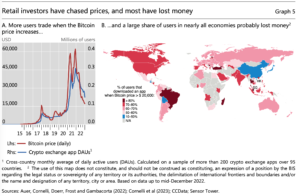
BISIH Reports on Cryptocurrencies, CBDCs for G20 Meeting
The Bank of International Settlements Innovation Hub (BISIH) submitted two reports on cryptocurrencies and central bank digital currencies (CBDCs) on July 11 in preparation for this month’s meeting of the G20 finance ministers and central bank governors.
The reports reached wildly divergent conclusions regarding the associated technologies. At 24 pages, the BISIH report on cryptography is the shorter of the two publications.
It provided a summary of the crypto ecosystem, which includes cryptocurrencies, stablecoins, and decentralized financing (DeFi), followed by a laundry list of “structural flaws and risks.”

Bitcoin price versus crypto exchange usage. Source: The Bank for International Settlements
The report on cryptocurrencies revisits some recurring issues, such as the centralization of much crypto trading, the instability of stablecoins, and the alleged irreversibility of smart contracts.
It raises some seldom-discussed issues, such as the centralization of DeFi that is unavoidable due to the need for an oracle. The BISIH crypto report also offered the relatively uncommon insight that human nature poses a risk.
It was noted that crypto investors tend to pursue prices that is, buy high and sell low just as is typical in conventional finance. The BISIH viewed crypto’s interconnectedness with the actual economy as the greatest threat.
“Institutional investors and households continue to show interest in cryptocurrencies despite the events of the past year,” the report stated, referring to the crypto winter.
In addition, the report asserted that increasing tokenization of assets could further stimulate the development of the cryptocurrency market, without explaining how.
Stablecoins could lead to the “cryptoization” of cash-strapped economies. The BISIH, along with the German and Dutch central banks, has launched Project Atlas to visualize cross-border crypto flows, but “further steps are required for a comprehensive assessment of crypto markets.” He added:
“Crypto’s inherent structural flaws make it unsuitable to play a significant role in the monetary system.”
The BISIH implemented 12 CBDC proof-of-concept or prototype projects over the past three years, out of a total of 29 projects, and learned valuable lessons, according to its CBDC report.
The report compares wholesale and retail CBDCs in terms of their desirability, practicability, and viability. The report summarized the vast majority of findings from all 12 initiatives and suggested potential applications for the information. Initially, it justified a research gap analysis.
The report stated, “Experimenting under the BISIH umbrella enables projects to build iteratively upon one another.”
“By underpinning the future monetary system, CBDCs would be the foundation upon which further innovations build.”
Additionally, BISIH projects could promote a “modular approach,” in which components such as payment, foreign exchange, and compliance could be “decoupled” from projects for broader application. The BIS has pledged that additional CBDC initiatives are forthcoming.





